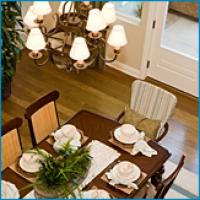Want to save energy in your dining room? Use these energy saving tips for your lighting, thermostat, air vents or radiators, and sliding doors.
Energy Efficient Lighting in the Dining Room
Chandeliers with many lights consume a lot of energy. If you have one, you may want to consider replacing it with a new, energy-efficient light fixture. There are many energy saving chandeliers, torchiere lights, ceiling mounted lights and wall sconces available to suit any taste. Most reputable lighting showrooms, home centers and specialty stores carry energy efficient light fixtures. Look for the ENERGY STAR logo to know you're getting an energy efficient model..
If you're not prepared to buy new fixtures, you can still save up to 75 percent on your lighting costs by replacing your incandescent light bulbs with ENERGY STAR qualified LED bulbs or compact fluorescent bulbs (CFLs). ENERGY STAR qualified residential LED bulbs use at least 75% less energy, and last 25 times longer than incandescent bulbs while providing optimal light color, and don't generate heat.
And remember, regardless of the bulbs you choose - always turn off the lights when you leave the room!
Save Energy with Your Thermostat
- Programmable Thermostats - You can save about $180 per year in energy costs with a programmable thermostat. Learn how to save energy with ENERGY STAR's programmable thermostat guidelines and saving energy with programmable thermostats.
- With a programmable thermostat, you don't have to remember to adjust the thermostat when you leave the house or when you go to bed. And you can set the thermostat to take into account the time it takes for the house to cool down or heat up, and have the house at a comfortable temperature when you arrive home or wake up in the morning. Choose the Right Programmable Thermostat.
- Manual Thermostats - You can save energy with a manual thermostat, too! Adjust your thermostat a few degrees higher in the summer and lower in the winter and save. Use a ceiling fan to increase your comfort (in winter, set the fan on low speed to gently push warm air down from the ceiling).
- For each degree you raise your thermostat in hot weather or lower your thermostat in cool weather, you can save two to four percent on your heating and cooling costs.
- To save energy, cool or heat your home only as much as necessary based on the time of day and occupant requirements. Contrary to popular belief, it costs more to keep a house constantly cool or warm than to cool it down or warm it up as necessary.
Keep Air Vents and Radiators Working Efficiently
Keep air vents and registers in your living room and throughout your home clear of furniture, drapes and curtains, allowing air to circulate freely. If your home is heated with radiators, put heat-resistant reflectors between the radiators and adjacent walls in order to better heat the room and reduce the amount of heat being absorbed by the wall.
Air Seal Around Sliding Doors and Throughout Your Home
Sliding patio doors are notoriously energy inefficient. The large glass surface allows lots of heat transfer, and insufficient air sealing around the doors creates drafts and allows heat to escape (or enter) the home. If this sounds like your sliding doors, apply caulk around the door frame and install weather-strip around the doors to reduce air leaks. If you're in the market to replace your sliding doors, choose ENERGY STAR qualified doors and save on energy costs, reduce drafts, improve your comfort and reduce fading of your interior furnishings.
Beyond your sliding doors, you can seal air leaks throughout your home to reduce uncomfortable drafts and save on your energy bills. Sealing the holes, cracks, and gaps in your home and duct system also helps prevent moisture problems.

Useful Energy Efficient Solutions:
- Attic Attic Ventilation, Duct Sealing, Chimney Sealing
- Basement Retire your old refrigerator!, Dehumidifier, Water Heater
- Bathroom Vanity Lights, Light Switch, Vent Fan
- Bedroom Bed-Side Lamp, Light Switch, Room Air Conditioner
- Dining Room Light Fixture, Light Switch, Programmable Thermostat
- Heating and Cooling Systems Table Lamp, Light Switch ...
- Home Office Desk Lamp, Ducts, Electrical Outlets, Power Strip
- HVAC HVAC air conditioning. HVAC Maintenance. HVAC contractor.
- Kitchen Light Fixture, Light Switch, Floor Vents/Radiators
- Living Room Table Lamp, Ceiling Fan with Lighting, Light Switch
- Outside House A/C Unit, Porch Light, Thermal Boundary
- Energy Efficient Windows Replace or Renovate, Energy Efficient Window Treatments
We were unaware of what was involved in an energy audit and your audior took the time to explain everything. We were impressed with the report which told us the areas in which we need to take action on. He never pressured us to use any particular contractors, he just suggested that we go to the Building Energy Pros web site to select contractors of our own choice. He did an excellent job and we HIGHLY recommend the Building Energy Pros. We already have recommended them to several of our neighbors. Again, EXCELLENT JOB!
Cynthia Simpson
The Building Energy Pros auditor was very knowledgeable. I was VERY HAPPY with him. He promptly E-mailed my energy audit report to me and I will consider all of his recommendations.
Tom McGee
We found out that our house really has no energy problems. We are happy to know that we
Leslie Stewart
I was very satisfied with your energy auditor. He was very qualified and spent a great deal of time with me. The energy audit was very informative.
P.B.
The energy auditor was very good and helpful. He keeps in touch with me to answer any of my questions.
D.G.
I was very satisfied with my energy audit. The auditor gave me some tips on attic insulation that were very helpful.
R.G.
I was very satisfied with my energy audit. Thank you!
R.S.
Very good service! I am going to replace the windows as the auditor had suggested.
D.W.
I was very happy with the energy audit. THANKS!
A. M.
My energy audit was very helpful. Joe Dempsey, your auditor, identified some structural problems that I was not aware of and explained to me why I need more insulation.
J. F.
The auditor was EXCELLENT! He spent ALOT of time with me. I am going to take 3 to 4 of his suggestions and correct these small items to save on my energy bills.
M. B.
The auditor did a GREAT JOB! He knew a lot about older homes, which we have. The report was very comprehensive. Thank you!
Vicki Nez/at
Your energy auditor was very nice and helpful. He answered all of our questions. We will recommend Building Energy Pros to our friends and neighbors.
Katherine McCaffrey
The auditor did a TERRIFIC JOB! The report was FANTASTIC! I will make all the repairs he suggested. I will definitely recommend him to everyone I know that could benefit from a home energy audit.
Steve Sleigh, Chevy Chase
The energy auditor was very professional and I am very satisfied with both the energy audit and the report I received. I will be referring the Building Energy Pros.
Tim Clary
I was very satisfied with the auditor. He was great and gave me some very valuable information. I will refer him to people I know who may need a home energy audit.
Willie Gantt
Your home energy audit proved to be very informative and helpful. I was not aware of the updraft created inside our walls because of the balloon framing construction. You said that that can cause heat to be pulled out of the house with the draft going up inside the walls and should be re-mediated. You also said that the attic insulation was insufficient and that fiberglass batts can leave spaces for around the edges causing heat loss and that it should have blown in insulation on top of what was there to seal the whole attic and increase the r factor. After going over your findings and telling me how you would fix the problems you told me how I could do it myself with stuff from the Home Center and for a quarter of the cost. Well, I did. I went into the basement and filled the bottom of the wall joist with unfaced insulation where they set on the sill plate. I then cut one inch foam board the size for each space and set it in and the sealed the edges of that with expanding foam as well as the sill plate to the foundation. I also sealed the sill plate to the foundation where the joist ran along it, as well as the top of those joist where it made contact with the subflooring. Next I went to the home center and rented their blown insulation machine and got ten bales of the insulation. I filled the attic on top of the batt insulation with about six inches giving another r-19 factor on top of the r-19 that was there. You said that the blown in would also help seal the heat loss around the edges of the batt. The work in the basement cost $144.00 and the work in the attic cost $328.00. After the 30% federal energy tax credit it will end up costing me about $330.00, which you said I should recover in savings in the first year. Thank You for all your advice and expertise. You made me aware of things I should consider and did.
Tommy Thompson



